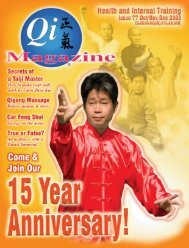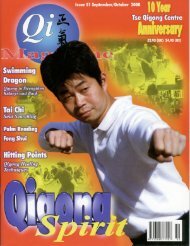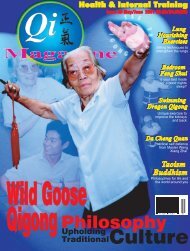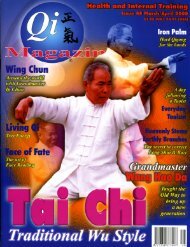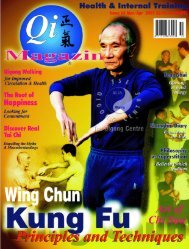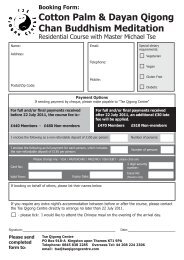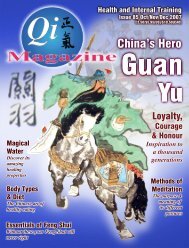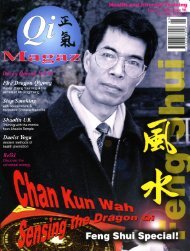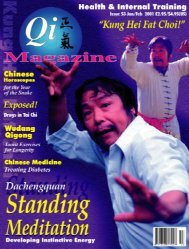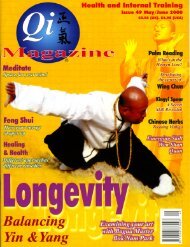Issue 57 - Tse Qigong Centre
Issue 57 - Tse Qigong Centre
Issue 57 - Tse Qigong Centre
Create successful ePaper yourself
Turn your PDF publications into a flip-book with our unique Google optimized e-Paper software.
Breast Lumpsand TCMTraditional Chinese MedicineIt is important that ladies check themselvesregularly so that any lumps in their breasts are foundquickly. TCM treats this condition in a number ofways depending on what is causing the problem.The Breast lump is a kind of noninflammationdisease. Its mainpathological changes arehyperplasia of the lobular mammarygland (an overgrowth of cells in thebreast tissue) and cystic degeneration.The condition is different frombreast cancer, but if it is left untreated itmay change to breast cancer. So it is veryimportant that women check their breastsregularly and from time to time visit aWell-Woman Clinic so that a doctor cancheck them. These clinics are staffed bywomen and often operate from local GPsurgeries.In Traditional Chinese Medicine(TCM), the main points of diagnosis are:1. This disease is commonly seen inyoung and middle-aged women between30 and 40 years old. The course isprolonged and may last several years.2. There are often a number of hardlumps of different sizes in one or bothbreasts. There is no distinct border linebetween the lumps. The lumps can bemoved freely in a fairly large range. Thesize of the lumps varies along withchanges in the patient’s mood. Theyenlarge when the patient is angry andthey reduce when the patient is happy.In the pre-menstrual period they becomebigger and they get smaller in the postmenstrualperiod.3. There is pain in the breast that is worsebefore menstruation and will be relievedafter menstruation. Ifthe patient is in a badmood she will have anobvious distendingpain and tenderness atthe location of thelumps in her breast.TreatmentConventional medicineusually treats thecondition by surgeryand the removal of thelumps. TraditionalChinese Medicine(TCM) usually treats itby herbal medicinewith a good successrate.Differentiation andTreatment ofCommonSyndromes:1. Stagnation ofthe liver Qi andcoagulation of phlegm.Main Symptomsand SignsThe condition is foundin young women whohave an impetuous temper and angereasily or who are in low spirits or in asilent huff. The patient will feel adistending pain or a stabbing pain in thebreast that will be worse before herperiod and will be relieved afterwards.The lumps in the breast are irregular andmay be enlarged or reduced as thepatient’s mood changes. The tongue ispale with a whitish coating. The pulse istaut and slippery.Treatment PrincipleRelieve the depressed liver. Regulate thecirculation of Qi and remove phlegm toactivate the channels in the breast.PrescriptionXiao Yao Lou Bei San, Cahi Hu, DangGui, Bai Shao, Fu Ling, Bai Zhu, Zhe Bei,Ban Xia, Gua Lou Pi, Mu Li, Shan Ci Gu,Tian Nan Xin.All the above herbs to be decoctedin water for oral administration2. Imbalance of the Chong and RenChannelsMain Symptoms and SignsCommonly seen in middle-aged women.The course of the disease is relativelylong. The patient looks thin and is in lowspirits. There is a low fever in theafternoon, sometimes with accompanyingrestlessness, insomnia,headache, dizziness and irritability,menstrual disorder and amenorrhea. Thelumps in the breast are hard and canbecome cysts. The tongue is slightly redwith a whitish coating. The pulse is deepand thready.Treatment PrincipleHarmonise the Qi and blood in theChong and Ren channels.PrescriptionEr Xian Tang, Xian Mao, Xian Ling Pi,Dang Gui, Ba Ji Tian, Zhi Mu, Huang BaiAll the above herbs to be decoctedin water for oral administration.In addition to the decoction, theherbal patents Dong Ling Cao Pian orXiao Yao Wan can be taken at the sametime to resolve the hard lumps in boththe above typesBy Dr. Shulan Tangemail : shulan@qimagazine.comQi Magazine 10



